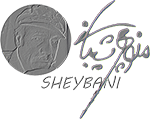

Born on November 29, 1924, in Kashan, Sheybani was the elder son of Farokhlaga
and Ali-Goli-Khan. He took pride in being related to two Qajar-era poets, Fat-Allah Khan
Sheybani (1825-1890) and Kamal-ol-Molk (1847-1940).
When he was seven years old, his father passed away, and shortly after, his mother remarried,
appointing his maternal grandfather, Gavam-ol-Soltan Gavam-Rezaee, as his guardian.
Due to his grandfather's work, the family moved around Iran frequently. Thus, Sheybani learned
about Iranian folklore and the country's landscape, which affected his art.
Sheybani and Taj, his grandmother, were extremely close. She insisted on him reading her
passages from Shahnameh and other favorite books every day before her afternoon nap.
She gave him early exposure to Eastern and Western literature, which helped him build a solid
literary foundation.
At the age of fifteen, he enrolled in an industrial school in Qaʾemšahr in Māzandarān, where he
received a diploma in textile manufacturing.
Employment in a textile factory provided him with a firsthand opportunity to experiment with
textile design and the composition of dyes (Babachahi; Hosseini). The textile school influenced his
knowledge and use of colors.
In 1943, he entered Honarestān-e Honarpišegi, Tehran’s first official performing arts school
affiliated with Edāra-ye Namāyeš, which was under Sāzemān-e Parvareš-e Afkār, founded by the
government in 1939.
He later entered the University of Tehran at the Faculty of Fine Arts In 1945.
Sheybani studied art and stage design under Rafi Hālati and came under the intellectual sway of
such celebrated figures as Abd-al-Ḥosayn Nušin, a noted scholar and stage director, who
encouraged him to study classical Persian literature (Babachahi). During that time, he also studied
with scholars like Ali Nasr, Rezazadeh, and Rafi Hālati and musicians like Parviz Mahmoudi and
Rubik Gregorian. He also later continued to study music with Madam Kosravi.
As a student, he participated in raising awareness of cutting-edge concepts in literature and art.
Sheybani, Sadegh Barirani, and Sohrab Sepehri earned the nickname "the three riflemen of
modern art" at that time at the University of Tehran's Faculty of Fine Arts. To propagate the
Art-Modern movement, they used their creative artistic concepts as weapons. Sheybani also
influenced other modern painters like Sohrab Sepehri, who recognized Sheybani's influence as a
turning point in his artistic development (Sepehri).
In 1949, he traveled to Italy to study interior design at Accademia di Belle Arti di Roma.
Together with Ziapur, director of the Department of Anthropology Museum, they explored the
country (Iran) while sketching and researching folklore art by gathering handicrafts from the
various locations they passed through. The importance of this one-of-a-kind collection was
recognized early on, leading to the establishment of the office of "folklore culture" inside the
Iranian Ministry of Art and Culture.
From 1972 to 1975, he traveled to France to extend his art by learning cinematography with
workshops & training in television production (ORTF, France).
Sheybani succumbed to cancer on 9 November 1991. He was survived by his wife Paridokht
Sobhi and his daughter, Aryana (Sheybani Zavosh).
His remains lay in Emam-Zadeh Taher in Tehran.
Exhibitions for Visual Art in Solo and groups in different countries.
Publication of four poetry books, the last one released after his passing. His poems were also
published in various with many others remaining unpublished.
He authored several articles published in different Journals with two of his play scripts published
into books.
He worked for the Ministry of Art and Culture after his university graduation until his passing.
He was affiliated with the Department of Anthropology Museum, the Persian National Opera
Department, and the Department of Theatre.
Sheybani wrote several Libretti for opera, Scenarios, and scripts for movies and theatre. He also
designed costumes and Stage decor for plays.
After his return to Iran from France in 1974, he started teaching at the College of Dramatic Art in
Tehran.

